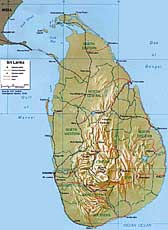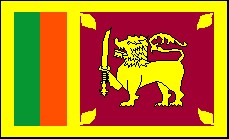-
-
- Sri Lanka Map
|
-
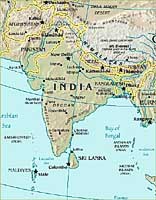
-
- Map of South Asia
|
|
-
|
- latest picture: May 8, 2011
|
-
-
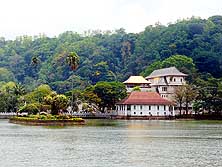
|
-
-
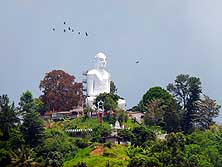
|
-
-
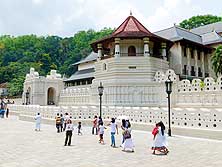
|
- 070
The “Tempel of the Tooth“ in Kandy
- is greeting from the lake shore. Here a
- tooth of Buddha is kept, one of the holiest
- relics; a UNESCO world heritage site
|
- 071
The Bahiravakanda Buddha
- watches from a hill over the lake
- region of Kandy, the second
- largest town of Sri Lanka
|
- 072
Pilgrims are walking along the
- “Temple of the Tooth“ towards its entry
|
-
- Kandy – 46 miles North of Nuwara Eliya – is not
only the second largest town. It is also the place of the “Temple of the Tooth”,
the most important Buddhist site in Sri Lanka. It is situated picturesquely at the lake
shore with the green forest as a backdrop. Here a tooth of Buddha is kept, one of the
holiest relicts. It attracts devotees not only from all over the island, but also from
other Asian countries.
|
-
-
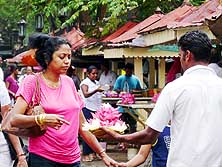
|
-
-
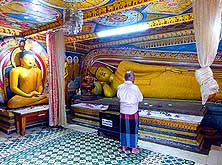
|
-
-
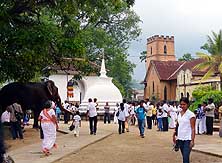
|
- 073
Offerings are part of the religious
- Buddhist rituals. On her way to the temple,
- a woman chooses an arrangement of
- Lotus flowers for Rp. 200 (= US$1.82)
|
- 074
A devotee prays in front of a
- reclining Buddha in a small temple besides
- Kandy’s “Temple of the Tooth”
|
- 075
Side by side: A Buddhist “Dagoba“
- and the Christian St. Paul’s Church in the
- area of the “Temple of the Tooth” in Kandy
|
-
- For us it is not essential having been inside the temple because only very
important visitors apparently get to see the tooth anyway. ”Ordinary mortals”
will see just the golden casket where it is kept. We regard Rp. 1’000 (US$9) entry
fee per person too much for just being rushed through – that many faithful are
queuing up. We rather concentrate on the life outside, which is for free and really worth
it.
|
-
-
-
-
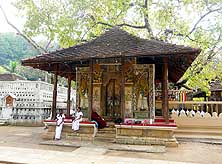
|
-
-
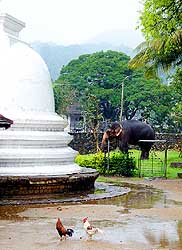
|
-
-
-
-
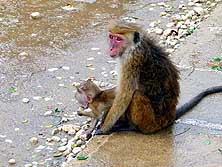
|
- 076
One of the four small Hindu
- shrines (Devales) besides the
- „Temple of the Tooth“ in Kandy
|
- 077
The elephant and the two cocks
- seem to like the tropical downpour in the
- area of Kandy’s “Temple of the Tooth” …..
|
- 078
..... and the monkey mother
- with her baby seems to enjoy
- the cooling-down too
|
-
- We join the families that came to pray, carrying a floral offering, mostly a bouquet of
beautiful lotus flowers. Depending on the size, a flower arrangement costs between 50
(US$0.45) and 200 (US$1.80) Rupees at the stalls. Their display is an eye-catching site.
An elephant, hordes of monkeys and even two cocks roam also around in the temple area
stretching along the shore of Lake Kandy, the town’s center point. It is an
atmosphere of peace that is surrounding us.
|
-
-
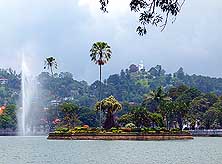
|
-
-
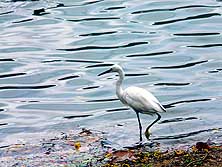
|
-
-
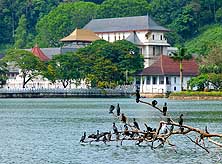
|
- 079
The small artificial island with
- flowers and the fountain at Kandy’s
- lake add to the city’s charm
|
- 080
A white heron picks in the
- shallow shore of the Kandy Lake
|
- 081
Black cormorants are cleaning and
- drying their feathers on a dead tree branch.
- From the other seashore Kandy’s
- “Temple of the Tooth” is greeting
|
-
- Only when the skies suddenly darken and a powerful tropical downpour surprises us, we
leave. We buy a cheese-onion pizza for Rp. 630 (US$5.70) at the Pizza Hut and with two
bottles of Lion beer from our car fridge we enjoy our today’s main meal at a lovely
spot at the lake shore.
|
-
-
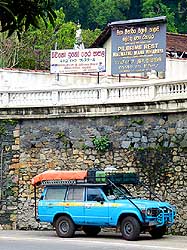
|
-
-
-
-
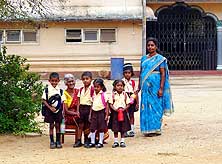
|
-
-
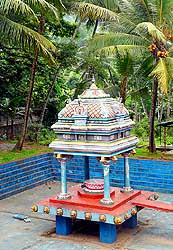
|
- 082
We are parking our LandCruiser
- at the Southern side of Kandy Lake
- near Malwathu Mahu Viharaya
|
- 083
Teacher and school children in
- the town of Matale, 17 miles North of
- Kandy, are eager to pose for a picture
|
- 084
A lovely miniature Hindu Temple
- between palm trees in the town of Matale
|
-
- Our main topic is the news of Osama Bin Laden’s death on 5/2/2011 in Abottabad in
Pakistan, which this morning spread worldwide like a bombshell. We recall 9/11. At this
day ten years ago in 2001 we were in the US selling “real” shells at a flea
market in Indiana to supplement our cash.
|
-
-
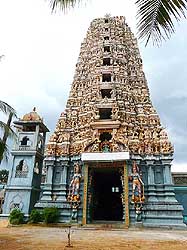
|
-
-
-
-
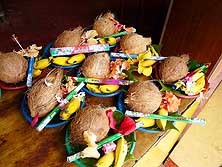
|
-
-
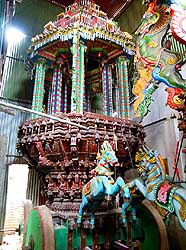
|
- 085
The Muthumariamman Thevasthanam
- Temple in the town of Matale between
- Kandy and Dambulla is the
- tallest Hindu temple in Sri Lanka …..
|
- 086
..... fruit offerings are
- sold at the temple entrance …..
|
- 087
….. one of the beautifully elaborated
- ceremonial “chariots”, pulled by ropes
- by thousands of devotees through the
- city during the Matale Theru Festival
|
-
- The roof of the ‘Temple of the Tooth’ is shining golden in the morning sun,
black cormorants are cleaning their feathers on a dry branch and white egrets pick in the
shallow waters of the lake shore when we leave Kandy. We head to Anuradhapura, 80 miles to
the North that belongs to the so called “cultural triangle”. It reaches from
Kandy over Anuradhapura and Polonnaruwa, and thereby includes also Dambulla, Sirigiya and
some smaller temple sites like Mihintale, Aukana and more. Actually there exists a
“cultural triangle ticket” for Rp. 5’400 (US$50). This entry ticket allows
“three for the price of two” of the above mentioned sites, but all the others
have to be paid additionally at the spot – pretty confusing and very expensive, as
all the locals pay only 5% or 10% of what a foreigner has to fork out.
|
-
-
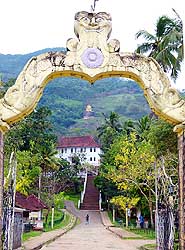
|
-
-
-
-
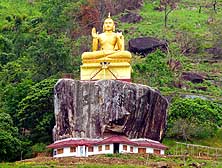
|
-
-
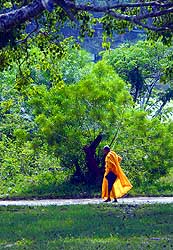
|
- 088
Gate to the Aluvihara monastery
- just North of Matale, where a golden
- Buddha is sitting on a huge rock
- boulder on a mountain slope …..
|
- 089
….. Close-up picture
- of the golden Buddha
|
- 090
A monk dressed in a
- saffron robe is on his way to a temple
|
-
- In Matale, between Kandy and Dambulla, we pass the ‘Muthumariamman Thevasthanam
Temple’, the tallest Hindu Temple in Sri Lanka. A watchman waves us aside to a shed.
He raises two tarps. Beautifully elaborated ceremonial chariots (carriages) appear, which
during Hindu festivals are pulled by ropes by thousands of devotees through the city, one
chariot for each deity. Shortly after a golden Buddha statue of the Aluvihara monastery,
sitting on a huge rock on a mountain slope catches our eyes. What an interesting religious
diversity!
|
-
-
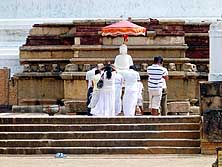
|
-
-
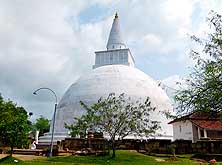
|
-
-
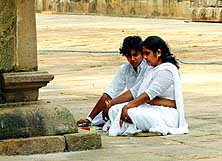
|
- 091
Devotees pray at the more than
- 2’100 years old Mirisavatiya Dagoba
- in Anuradhapura, the capital of the
- ancient kingdom of Sri Lanka …..
|
- 092
..... the Mirisavatiya Dagoba
- is one of the eight sacred
- sites in Anuradhapura …..
|
- 093
..... two young people
- meditate in a quiet corner
|
-
- Anuradhapura, the capital of the biggest ancient kingdom of Sri Lanka, exceeds by far
our expectations. In its heyday it is said to have been the biggest monastic city of the
ancient world with dozens of monasteries and ten thousands of monks. We are especially
fascinated by the historic, monumental dagobas, called also stupas and pagodas.
|
-
-
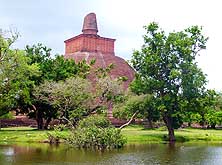
|
-
-
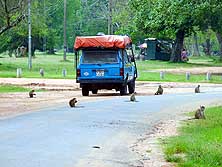
|
-
-
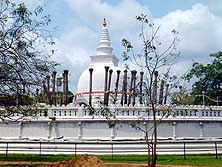
|
- 094
The Jetavanarama Dagoba (400 ft.)
- in Anuradhapura was the tallest ever
- built Dagoba. 93.3 millions
- of red bricks were used
|
- 095
Cheeky monkeys wait for
- an unattended moment to climb
- to the roof of our LandCruiser
|
- 096
The Thuparama Dagoba in Anuradha-
- pura is considered to be the first Dagoba
- in Sri Lanka (250-210 B.C.). It was
- rebuilt in 1862 due to destruction
|
-
- They have been built to protect the holiest relicts of Buddhism. In a shiny white they
tower towards the skies. According to our guide book, from all the architectonic
masterpieces of earlier civilizations only the pyramids of Gizeh in Egypt are said to be
bigger than the three main domes in Anuradhapura. We are awestruck by its mere
grandiosity.
|
-
-
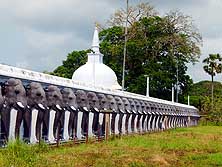
|
-
-
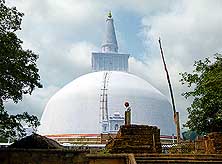
|
-
-
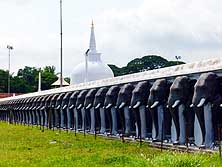
|
- 097
Here at the Northern protective wall
- of the Ruvanvelisaya Dagoba (was once
- 338ft. high; 370ft. circumference) in
- Anuradhapura hundreds of elephants are
- standing guard shoulder by shoulder …..
|
- 098
….. the immaculate white
- Dagoba is one of the
- masterpieces in Sri Lanka …..
|
- 099
..... the Western part of the wall
- in the North is the counterpart of the
- Eastern part – hundreds of guarding
- elephants. There are 1’900 figures
- within the whole Dagoba
|
-
- In this city stands also the most worshipped tree of the world, the holy „Sri Maha
Bodhi“ (a kind of fig tree). It originates from a seedling of the original tree of
Bodhgaya in India, under which Buddha found enlightenment and from where his teaching
spread. The oldest branch is carefully supported with golden crutches and the whole tree
itself – it is one of the oldest trees worldwide – is protected by a railing. It
looks rather unimposing and we almost missed it. Entry is through a little gate, where
shoes have to be deposited and where visitors are checked. In general, the presence of the
police at those holy places is quite big; no wonder because also Anuradhapura was hit on
10/6/2008 by a suicide bomb attack of the Tamil Tigers.
|
-
-
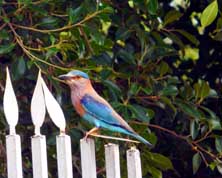
|
-
-
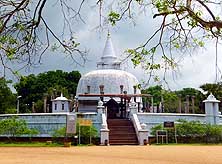
|
-
-
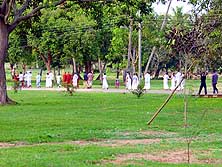
|
- 100
The lovely Indian Roller
- (Coracias benghalensis), called also
- Blue Jay, apperas at the Stupa
|
- 101
The Lankarama „Vatadage“ in
- Anuradhapura – a relic house consisting
- of a small Dagoba, flanked by Buddha
- images and encircled by pillars
|
- 102
Anuradhapura: A procession of
- devotees and monks walk to the most
- worshipped tree of the world - the holy
- “Sri Maha Bodhi” (a kind of a fig tree)
|
-
- After two days we are on our way again – in Southeastern direction to the second of
the ruined cities of Sri Lanka: Polonnaruwa – once a flourishing trade and religious
center. For some reason, we are in not in the same mood today to stroll around the ruins
and stones of a by-gone empire as we were end of 2005 in Cambodia,
at least not for a daily tourist entry fee of US$25. We therefore concentrate to the
Southern, entry free part near the Polonnaruwa Rest House, where once Queen Elizabeth II
has been lodging. Langur monkeys romp between stony witnesses, pillars and an impressive
stony lion. They bring some life into the clutter of stones.
|
-
-
-
-
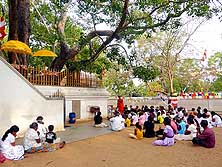
|
-
-
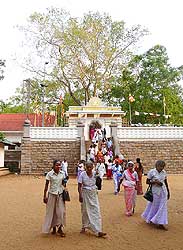
|
-
-
-
-
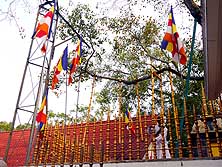
|
- 103
A monk is praying with devotees
- at the „Sri Maha Bodhi“ tree in Anuradha-
- pura. It originates from a seedling of the
- original tree of Bodhgaya in India, under
- which Buddha found enlightenment …..
|
- 104
….. after prayer the
- devotees leave the holy site of
- the “Sri Maha Bodhi” Tree …..
|
- 105
..... the oldest branch is carefully
- supported with golden pillars and the whole
- tree itself is protected by a golden railing.
- It’s said that it was planted 288 B.C. or
- 246 B.C., what makes an age of more than
- 2’250 years, hence the oldest living tree
|
-
- Mid morning of the following day we leave Polonnaruwa on the very smooth A11-trunk road
towards the East. The villages end, the traffic gets scarce and for the first time we
encounter military checkpoints, one after the other. Either they occupy the primitive
military sheds that line the road, or they are busy standing guard with a shouldered gun
at the road side.
|
-
-
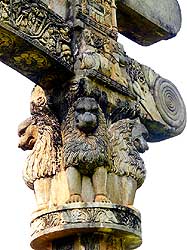
|
-
-
-
-
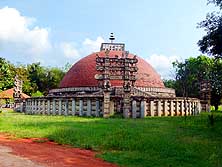
|
-
-
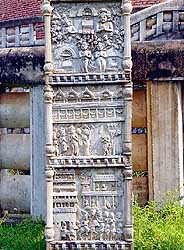
|
- 106
The pillar with lion heads is a
- supporting element of the dome shaped
- temple opposite the University Park in
- Mihintale, 9 mi. East of Anuradhapura …..
|
- 107
….. the huge structure of the
- dome shaped temple shows beautifully
- elaborated reliefs on panels in each
- four cardinal directions …..
|
- 108
..... detail of one of the panels
|
-
- Is it a hangover of the civil war fought until 2009 between the Hindu Tamils and the
Buddhist Sinhalese? Or is it merely providing jobs? Or even both? During the war lasting
two decades, the Tamils living in the North advanced along the East Coast of the island
all the way to the Yala Nationalpark in the South.
|
-
-
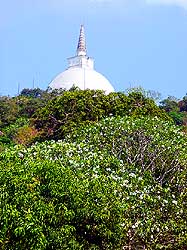
|
-
-
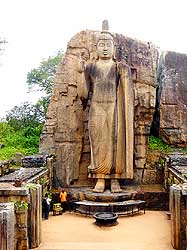
|
-
-
-
-
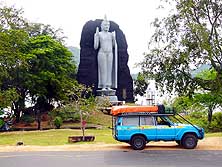
|
- 109
The Maha Dagoba of the
- temple complex in Mihintale,
- 10 miles East of Anuradhapura,
- greets from the hilltop
|
- 110
About 10 miles West of the main high-
- way from Dambulla to Anuradhapura stands
- the 40ft. tall Aukana Buddha, carved out of a
- single rock in the 5th century. Since the Taliban
- destroyed in March 2001 the biggest Buddha in
- the world back then in Bamiyan/Afghanistan,
- this one became Number 1
|
- 111
On the road to Polonnaruwa
- another huge, but newly built
- Buddha is greeting at Minneriya
- along the Minneriya Tank
|
-
- The military checkpoints wave us through without exception contrary to the police in
their brown uniforms, who start to flag us down more and more. Slowly but surely they get
on our nerves. „Why are you always stopping us? What did we do wrong?“ –
Emil starts to ask in an upset manner. That usually disconcerts them and with a broad
smile they make us a sign to proceed. Only once a senior police officer got grumpy and
insisted to see Emil’s international driver's license, as if we had received a permit
for our car to drive around Sri Lanka without having a driver's license.
|
-
-
-
-
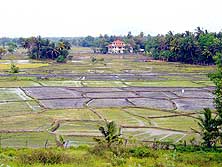
|
-
-
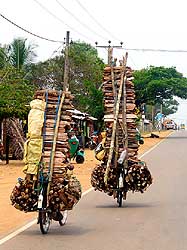
|
-
-
-
-
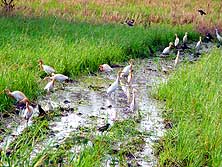
|
- 112
Freshly planted rice fields
- in Polonnaruwa
|
- 113
An unusual street picture: Two
- bicycles highly loaded with timber. Fire-
- wood has be to carried from far away
|
- 114
Flocks of Cattle Egrets
- are a common sight on the fields
|
-
- We are driving towards the East coast through “no man’s land” along a
flat steppe with shining yellow grass, intercepted by green trees. Automatically our
thoughts return to the African savanna. It was long, long ago!
What a beautiful sense of emptiness and freedom! However as soon as we reach the East
coast the density of the population restarts.
|
-
-
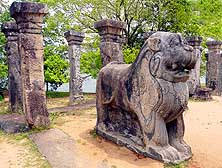
|
-
-
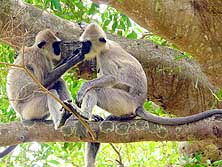
|
-
-
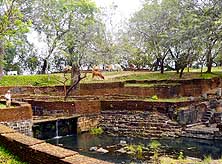
|
- 115
A beautifully sculptured lion amidst
- lonely stone pillars in the Southern ruined
- city of Polonnaruwa. The ancient city
- of Polonnaruwa is listed also as a
- UNESCO world heritage site …..
|
- 116
….. Hanuman langurs live
- on the trees between the ruins …..
|
- 117
..... Emil is standing at the edge of
- the historic sluice of the “Royal Baths”
|
-
- Here we reach also the area, where on December 26th, 2004, the Tsunami struck, leaving
more than 35’000 people dead – after Indonesia
the most casualties. We feel that people are poorer than in the West. There are a lot of
bicycles – in the West we hardly have seen any – and motorbikes are on the
increase. On the other side, there are fewer cars. But the new LandCruisers of the UN are
still circulating.
|
-
-
-
-
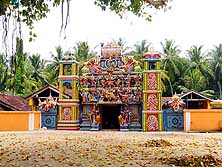
|
-
-
-
-
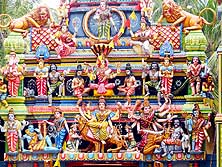
|
-
-
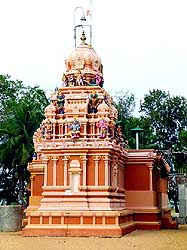
|
- 118
One of the lovely Hindu temples along
- the East coast close to Chenkaladi …..
|
- 119
….. details of the goddesses
|
- 120
Another small Hindu temple
|
-
- Hindu temples replace now the Buddhist temples of the West and Christian churches are
somewhat increasing. Skinny cows roam freely around. People are more curious. “What
is your name?”, “Where are you from?“, “How many babies do you
have?“ – it is India pure! Early afternoon we are already in Batticaloa and
cross the single-lane bridge to Kallady. There, the Tsunami hit really badly. Part of the
coastal road has been swept away; the bypass is still merely an earth track. There,
directly at the white sandy beach, we find a lovely spot for lunch.
|
-
-
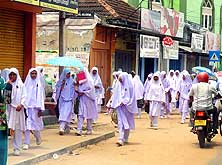
|
-
-
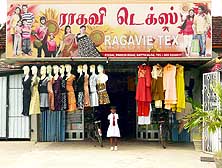
|
-
-
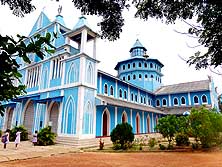
|
-
|
- 121
A Moslem School has finished
- in Maruthamunai near Kalmunai on the
- East coast – the girls are heading home.
- On the East coast live predominantly
- Muslims and Hindus, some Christians
- and just a few Buddhists
|
- 122
A small shop selling
- dresses in Batticaloa
|
- 123
The eye-catching blue
- church “Our Lady of Sorrows”
- (or “Our Lady of Presentation”)
- in Batticaloa is eight-sided
|
-
- While we eat bread and a can of tuna fish, we watch out to the sea, which is calm today.
It is a strange feeling to imagine that all of a sudden it could change into a disastrous
inferno erasing everything in its way. But life goes on: Two fishermen are bouncing with
their canoe on the waves and waiting for the right moment to throw their net. At the beach
four women are breaking off branches of young casuarinas trees, replanted after the
Tsunami. They bundle them to take them home as firewood.
|
-
-
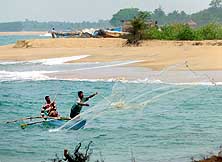
|
-
-
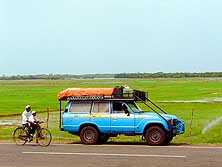
|
-
-
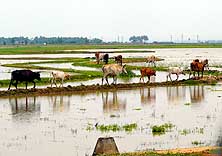
|
- 124
A fisherman is casting his net
- in Kallady near Batticaloa
- at the East Coast
|
- 125
We drive through the fertile
- plains fromBatticaloa to the
- more Southerly Arugam Bay
|
- 126
A rural scene on the
- East coast after heavy rains
|
-
- South of Batticaloa the image is changing dramatically. The elaborated Hindu temples are
replaced by uniform green painted mosques (green is the color of Islam). After the school
hours, children and students in their traditional Arabic outfit are swarming by the
hundreds to the streets. 50 miles further, at Arugam Bay – a surfer and hanger
paradise – the call of the muezzin to pray interrupts the night hours at 5am –
the first time after our visit of Socotra in Yemen. Yes, there is no doubt: We are in a Muslim corner of Sri
Lanka. 7.5% of the population are Muslim, 70% Buddhist, 15% Hindus and around 7.5%
Christians.
|
-
-
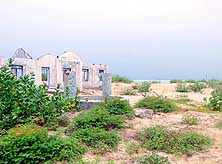
|
-
-
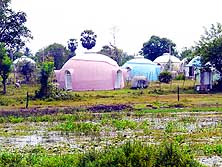
|
-
-
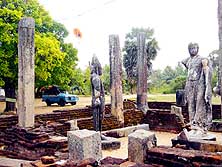
|
- 127
A few remaining ruins along the
- East coast are silent witnesses of the
- Tsunami of December 26, 2004
|
- 128
Emergency shelters at Pottuvil for
- Tsunami stricken people along the East
- coast. Although the East coast bore the brunt
- of the disaster, Sri Lanka was hit all around
- very badly: 35’000 dead and missing
|
- 129
The historic ruins of 'Mudu Maha
- Vihara' at Pottuvil in the East. There
- is a 10ft.-high standing Buddha and
- two smaller statues
|
-
- Before the 2004 Tsunami Arugam Bay was considered also a kind of “Ceylonese hippie
center”. Our impression is that the situation is partly returning. It is not
“our” place. Therefore, next morning we are on our way again. We backtrack to
Potuvil and turn inland, thus driving West, following the highway A4. Ponds with carpets
of white blooming water lilies pop up.
|
-
-
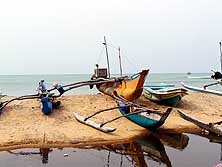
|
-
-
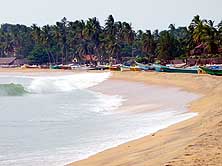
|
-
-
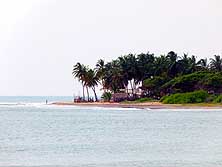
|
- 130
Fishing canoes are parked at a sand-
- bank at Arugam Bay. It’s said that due to the
- Tsunami boat donations were so generous
- that some fishermen owned a small fleet
|
- 131
The picturesque beach of Arugam
- Bay is lined with colorful fishing boats.
- Arugam Bay is also famous as a surfer
- paradise. This beach place was before
- the 2004 Tsunami from time to time a
- kind of “Ceylonese hippie center”
- (if the political situation allowed it)
|
- 132
No road noise – just beach,
- sea and sun at Arugam Bay
|
-
- We spot our first wild elephant taking a bath, two pairs of wild peacocks and swarms of
water fowls. It is so peaceful, but the heat is nearly unbearable. It is said to be the
hottest region of Sri Lanka. Despite of it, in Wellawaya we make a little detour to
Buduruwagala to see the seven Buddha figures carved into a sheer cliff. The biggest statue
is 52ft. high. Really very impressive!
|
-
-
-
-
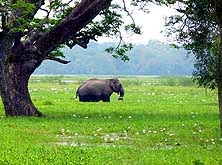
|
-
-
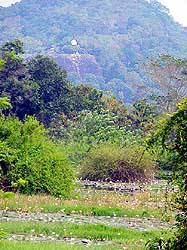
|
-
-
-
-
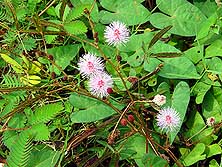
|
- 133
In the vicinity of the small Eastern
- 'Lahugala Kitulana National Park'
- we see our first wild elephant
|
- 134
The highway No. 4 to the West
- leads us through a serene landscape
- with many water lily ponds
|
- 135
The “Mimosa pudica“ is a sensitive
- flower. Its leaves shrink when touched
|
-
- Then the cool mountain air is calling. A good tarmac road leads up to Ella, a popular
tourist village on 3’400ft. altitude. Shortly before we arrive, we cross the Rawana
Ella waterfall that plunges through a rocky gorge from a height of 82ft. down to the
valley. As it is the case in most touristy places, cheeky monkeys are on the spot
immediately. Woe betide those who do not close their car windows or doors immediately!
|
-
-
-
-
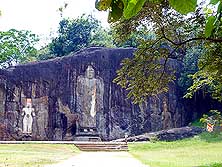
|
-
-
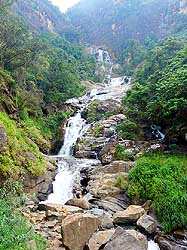
|
-
-
-
-
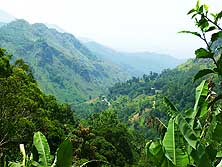
|
- 136
The Buduruwagala Buddha figures
- cut into a sheer rock near Wellawaya
- (3 miles South on A2 and 2 miles
- West on a narrow side road)
|
- 137
The Ravana Ella Falls between
- Wellawaya und Ella rumble
- down 82ft. through a rocky gorge
|
- 138
The highly praised Ella Gap where
- at a clear day the coast should be seen
|
-
- A few miles further, after a short but badly potholed stretch, the quaint restaurants of
the small mountain resort are greeting. We hardly reach the first buildings that we are
already out of the village again. Apart of the mountain scenery with the highly praised
Ella Gap and a railway station there is not much to admire though. But the cool air is
just all we need for now, before we descend again to the plains of Southern Sri Lanka. We find a lovely room at the Country
Comfort Hotel with an inviting bay window.
|
-
-
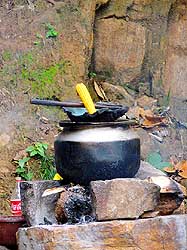
|
-
-
-
-
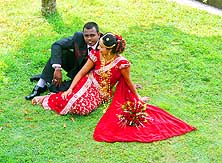
|
-
-
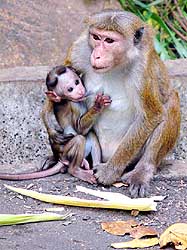
|
- 139
An inviting snack at the
- site of the Ravana Ella Falls
|
- 140
A newlywed couple enjoys
- the view over Ella Gap
|
- 141
Where there are tourists, there
- are also monkeys (there is something
- to guzzle). Here at the Ravana Ella
- waterfall some ‘Toque Macaques’
|
-
|
More websites from Sri Lanka:
- Part 1: Colombo - Negombo - Sigiriya - Dambulla - Colombo - Nuwara Eliya - Peradeniya (before
Kandy)
- Part 3: Ella
- Haputale - Tissamaharama - Tangalle - Galle - Colombo
|
-
- Articles in newspapers about us in Sri Lanka:
- Article: "Record breaking cruise",
Daily Newspaper "Daily News" - April 22, 2011
- Article: "Around the world
on a steady truck", Weekly Newspaper "Sunday Observer" -
April 24, 2011
|
![]()
